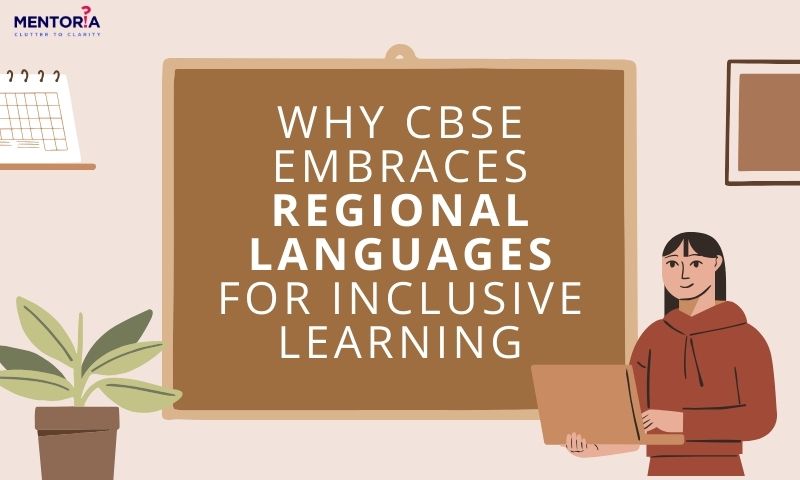Why CBSE Embraces Regional Languages for Inclusive Learning

The Central Board of Secondary Education (CBSE) has made a significant stride toward inclusivity and embracing cultural diversity within the Indian education system. Recently, Union Education Minister Dharmendra Pradhan disclosed that CBSE schools across the country will introduce instruction in 22 regional languages, such as Odia, alongside Hindi and English. This decision resonates with the objectives outlined in the New Education Policy (NEP), aiming to empower students through education in their native languages. CBSE’s embrace of this linguistic diversity aims to elevate educational standards and cultivate a more profound comprehension of subjects among students. Up until now, CBSE schools have mainly relied on Hindi and English for teaching, but there’s growing recognition of the advantages of using regional languages as a medium of instruction. Research indicates that students grasp concepts better when taught in their native tongue, as it creates a familiar setting that aids in understanding and remembering information, leading to improved academic performance.
By adopting regional languages, CBSE acknowledges India’s cultural diversity and enables students to communicate and relate more confidently to their heritage. Education in a student’s mother tongue encourages a stronger sense of identity and cultural pride while nurturing a deeper respect for diverse traditions. The blog highlights cultural inclusivity and how the inclusion of regional languages improves cognition in younger children. It also talks about the importance of preservation of regional languages, necessary support from parental figures, and challenges one can encounter while implementing this.
Cultural Inclusivity and Identity
With CBSE giving the green light to teaching in regional languages, it’s not just about textbooks and classrooms; it’s a celebration of who we are. Imagine a classroom where students engage with mathematical formulas in a language that resonates with their cultural heritage. It’s more than excelling in exams; it’s about fostering a connection and immense pride in one’s cultural identity. This shift acknowledges that language holds not just communication but the stories, traditions, and intricacies of a community.
For students, this change is transformative. No longer will they feel out of place while studying biology or delving into the complexities of physics. Instead, it’s an opportunity to navigate the educational landscape using a language that feels familiar, where concepts aren’t alien, and words aren’t strangers. This move toward cultural inclusivity goes beyond being a trendy term; it’s a reality. It’s a statement that says, “Your language and culture matter.” It’s a stride toward shaping an educational environment that doesn’t merely teach subjects but weaves a diverse tapestry of identities, allowing every student to find themselves reflected in the curriculum. So, as we assess the impact of CBSE’s language transformation, remember, it’s not just about what’s being taught; it’s about who we become through this journey.
Improving Student’s Cognitive Development
At the core of this linguistic revolution lies the idea that the brain is not just a passive recipient of information; it’s an active constructor of knowledge. When students engage with complex subjects in their mother tongue, it’s like providing them with a cognitive shortcut. The brain doesn’t translate; it absorbs and processes information directly, making comprehension more efficient. Cognitive science research emphasises the close relationship between language and thought. The words we use to convey ideas shape how we perceive and understand those ideas. CBSE’s decision to allow students to express themselves and participate in discussions in their native language creates a cognitive space where ideas can be shaped more flexibly and deeply.
Additionally, the emotional connection to one’s mother tongue significantly impacts memory retention. When concepts are learned in a language with emotional resonance, they tend to stick in long-term memory. This emotional engagement can turn the learning process from a task into a journey of self-discovery. Imagine a student solving a maths problem or unravelling historical events in a language that evokes memories of family lullabies or whispered stories during gatherings. Learning isn’t just mental; it’s synchronised with a cultural rhythm that enriches the learning experience.
Essentially, cognitive development extends beyond excelling in exams; it’s about nurturing minds capable of navigating the complexities of the world deeply and adeptly. CBSE’s embrace of regional languages isn’t just about changing the curriculum; it’s shaping a cognitive landscape where learning isn’t passive but an active, vibrant exploration of knowledge. As we analyse the impact of this linguistic shift, it’s evident that cognitive development isn’t incidental; it’s the core essence of a more enriched and profound educational journey.
Preservation of Regional Languages
The preservation of regional languages is not just about what’s taught in the classroom; it’s a profound step towards safeguarding the very essence of linguistic diversity that defines our cultural landscape. In a world where dominant global languages often overshadow local dialects, CBSE’s choice stands as a stronghold against the erosion of linguistic heritage. It’s not just an educational change; it’s a connection between past and present generations.
Regional languages, long neglected in academic settings, are now gaining prominence. Envision classrooms as spaces where languages thrive, adapting to our changing educational landscape. This transformation emphasises that every language, whether widely spoken or by a smaller community, holds stories, wisdom, and distinct viewpoints. By integrating regional languages into the mainstream curriculum, CBSE sends a powerful message – these languages are significant. They’re not relics; they’re vibrant entities deserving a significant place in education. It’s a celebration of the richness of our linguistic heritage, acknowledging that diversity isn’t merely accepted; it’s embraced. Yet, there are challenges ahead. Providing high-quality educational resources in these languages requires attention. Collaboration with publishers, educators, and communities is crucial to develop a curriculum that not only preserves regional languages but also helps them thrive.
Preserving regional languages isn’t just about adjusting a curriculum; it’s a cultural revitalisation. It’s about nurturing linguistic ecosystems that might fade due to global linguistic dominance. As we embark on this linguistic rejuvenation, it’s evident that CBSE’s decision isn’t solely about teaching subjects; it’s about safeguarding the essence of our diverse linguistic legacy.
Challenges and Solutions
The CBSE faces several challenges in integrating regional languages into the educational landscape. overcoming initial obstacles revolves around the scarcity of high-quality educational materials in regional languages. To tackle this, CBSE could collaborate with renowned publishers and educational institutions to create and standardise content meeting top-notch standards. This involves close collaboration with language experts, educators, and local writers to ensure linguistic accuracy and cultural significance in the content.
Another challenge involves ensuring a proficient pool of teachers proficient in regional languages. Initiating teacher training programs can enhance language proficiency and equip educators with the tools to deliver excellent education in diverse linguistic settings. Incentives like scholarships and professional development opportunities can attract skilled educators, forming a strong teaching cadre.
Raising parental awareness and support for regional language instruction is another vital task. Conducting awareness programs, workshops, and interactive sessions can help parents understand the benefits of this approach and foster a supportive home atmosphere. CBSE could organise regular sessions specifically aimed at educating parents about the advantages of regional language instruction. Addressing their concerns, sharing success stories, and involving them in decision-making processes can turn parents into advocates for this innovative educational model.
Overcoming these challenges requires proactive, collaborative, and strategic approaches. By tackling these hurdles upfront, CBSE has the opportunity to create an educational environment where every student, regardless of their language, has an equal chance to thrive and succeed.
Parental Involvement and Support
The CBSE’s initiative to introduce regional language instruction faces several hurdles. Firstly, there might be scepticism among parents about the effectiveness of this approach, potentially leading to resistance. To address this, CBSE could launch targeted campaigns directly aimed at parents, highlighting the advantages of learning in regional languages and sharing success stories to illustrate its positive impact.
Secondly, disparities in language proficiency might hinder parental involvement in their children’s education. CBSE could provide support by offering language courses, online resources, or community programs to assist parents in enhancing their language skills. This effort aims to bridge the gap between the language spoken at home and the one used in the educational setting.
Lastly, resistance to change is a common challenge, and the transition to regional language instruction might encounter opposition from parents accustomed to the traditional English-centric model. Addressing their concerns through dialogue, informative sessions, and involving them in the decision-making process could help ease the transition and garner parental support. Addressing these concerns with understanding and open communication could ease this transition.Transparent communication and collaboration between schools and parents are crucial, fostering a sense of ownership and support. Encouraging parental support at home can indeed be tricky. Rolling out programs that guide parents on supporting their kids’ education at home could work wonders. Workshops covering effective study habits, language resources, and guidance on navigating this new educational path could empower parents to be active contributors to their children’s academic journey. After all, parental involvement can shape the course of educational change. By tackling these hurdles and putting strategic solutions in place, the CBSE can craft an environment where parents enthusiastically join the quest for a more diverse and inclusive education system.
National Integration
The CBSE’s move to introduce regional languages as a medium of instruction carries profound potential for national integration. By championing regional languages in education, CBSE isn’t merely emphasising language; it’s nurturing equality and cultural understanding. It’s akin to embarking on a cultural exploration through learning, bringing together students from diverse linguistic backgrounds under a unified educational platform. India’s unity amidst diversity is a powerful asset, and education plays a pivotal role in making this unity more palpable.
This change isn’t symbolic; it’s a means to infuse diversity into education, bridging linguistic divides among students and establishing the groundwork for a more cohesive society. Moreover, teaching in regional languages has the capacity to mitigate socio-economic disparities often associated with language barriers. It creates opportunities for students from different backgrounds, offering an equitable chance at academic success. This isn’t just an educational adjustment; it’s a strategic move toward a more integrated nation. It recognises that true unity flourishes in celebrating India’s diverse languages and cultures. As CBSE leads this educational transformation, it’s evident that they’re shaping a future where India stands more harmonious and united.
Their decision signifies a significant step toward embracing cultural inclusivity, preserving linguistic diversity, and improving education quality across the nation. Challenges might exist, but with careful planning, collaboration, and a dedication to equality, this shift promises not only cultural roots for students but also a vision for a more united and diverse India.
Empowering Learning Through Mentoria
The CBSE’s Regional Renaissance programme is an important initiative that will benefit students, teachers, and society as a whole. Mentoria provides access to mentors from a variety of backgrounds and industries. This allows individuals to find counsellors who can provide them with the guidance and support they need to achieve their goals. We also provide a platform for individuals to connect with each other, share experiences, and learn from each other.









